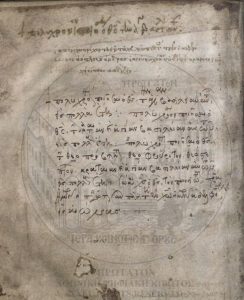Curious to learn more about Byzantine riddles? 🤓 Today, the anniversary of the publication of Tolkien’s ‘The Hobbit’ is the perfect occasion to dive a bit deeper into this topic.
The metrical riddle quoted in our story is found in the manuscript Athon., Protat. 29, where it was written by a later scribe in the 15th century among a series of praising formulas meant to be chanted at the end of a liturgy in order to wish a monastic community a long life. The many occurrences of riddles in different manuscripts testify to their popularity in the Byzantine world. Teachers, for instance, eagerly used this genre for didactic purposes (in relation to the practice of schedography, a playful way to teach grammar.

✒️ Ἵππον ἔχω τρέχοντα λευκῷ πεδίῳ,
τρεῖς ἐπιφερόμενον ἀόπλους ἄνδρας·
ἐὰν οὐ σχίσῃς τοῦ ἵππου τὸ κρανίον,
ὁ ἵππος οὐκ ἰσχύει περιπατῆσαι.
📖 I have a horse trotting over a white plain
which bears three men unarmed.
If you do not break the horse’s skull
the horse will no longer be able to trot.
🌐 https://www.dbbe.ugent.be/types/34818
The solution to this riddle is ‘kalamos’ (κάλαμος), ‘reed pen’. The horse represents a pen with which the scribe writes on an empty folio (the white plain). ✍️ Furthermore, the three men are the three fingers used for writing. They are supposed to guide the horse in the right direction, in the same way as the fingers have to make sure the pen writes legible letters. The cruel breaking of the horse’s skull, on verse 3, refers to the practice of sharpening the pen, necessary to guarantee the quality of the writings. So far, our horse-riddle has been discovered in two Byzantine manuscripts, but other versions of the epigram widely circulated in Byzantium. In other languages, variants of the horse-riddle occur as well, such as the famous Veronese Riddle and the Exeter Book Riddles.
As a world-renowned professor of Old English, Tolkien used his expertise as a source of inspiration to his novels. This results in the multitude of riddles which are to be found in ‘The Hobbit’. One of these strikingly resembles our riddle:
“Thirty white horses on a red hill,
First they champ,
Then they stamp,
Then they stand still.”
Is there a link between Tolkien’s riddle and the Byzantine one? Admittedly, probably not in a direct sense, except from the use of the horse metaphor. 🐎 However, both are part of a larger tradition. Riddles, namely, constituted a (prestigious!) literary genre in the Latin and, later, Anglosaxon tradition.